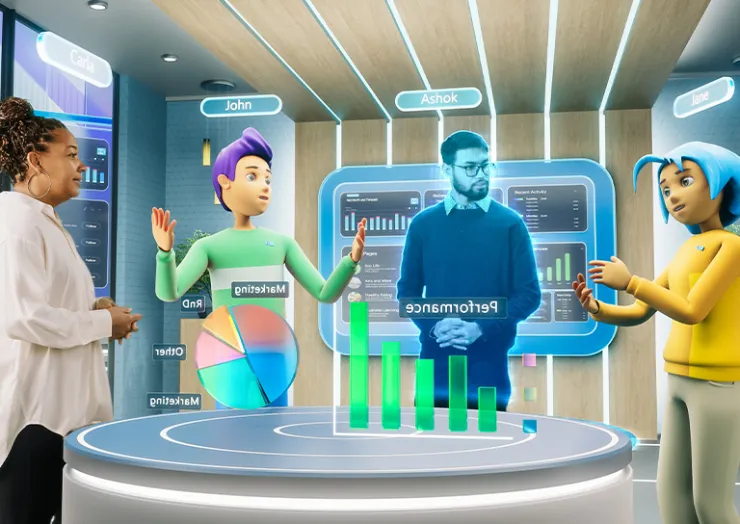
In the rapidly evolving world of digital commerce, the line between human and machine-driven customer interaction is blurring. One of the most transformative innovations leading this change is the rise of AI-generated avatars — digital humans powered by artificial intelligence that can see, speak, and respond just like real salespeople. These avatars are redefining the sales experience by making digital engagement more personalized, scalable, and human-like.
The Evolution of Virtual Sales –
Traditional e-commerce interactions have long relied on chatbots and scripted messaging to assist customers. While functional, these tools often lack emotional intelligence and the ability to build trust — critical components in the buying journey.
AI-generated avatars bridge this gap by combining natural language processing (NLP), computer vision, and generative AI to create lifelike virtual sales representatives. They can understand speech, interpret facial cues, and respond in real-time with human-like tone and expressions. The result: a customer experience that feels more authentic and immersive.
What Are AI-Generated Avatars?
AI avatars are digital personas powered by advanced neural networks capable of replicating human behavior. They are designed using a combination of:
- Text-to-speech (TTS) and speech-to-text (STT) technologies for natural conversation.
- 3D rendering engines for lifelike facial expressions and body movements.
- Machine learning algorithms trained on thousands of human interactions to improve emotional responsiveness.
These avatars can be deployed on websites, mobile apps, or in virtual showrooms — offering customers 24/7 access to sales assistance without fatigue, delays, or inconsistency.
How Virtual Salespeople Transform the Customer Journey –
- Hyper-Personalized Engagement – AI avatars can analyze a visitor’s preferences, purchase history, and behavior in real-time. This allows them to tailor recommendations, product demonstrations, and responses with precision — just like a seasoned salesperson who knows their client.
- Scalable Human Interaction – Unlike traditional sales teams, AI avatars can engage with thousands of customers simultaneously. Businesses can deliver personalized attention at scale, without the overhead of training and staffing.
- Enhanced Brand Consistency – Every avatar interaction follows brand guidelines for tone, messaging, and visual identity. This ensures customers receive consistent, on-brand experiences across all touchpoints.
- Emotionally Intelligent Responses – With advances in affective computing, avatars can interpret emotional cues such as frustration, excitement, or hesitation — and adapt their tone or behavior accordingly, building deeper customer trust.
- Multilingual & Cross-Cultural Communication – AI avatars can converse fluently in multiple languages and dialects, making them ideal for global brands looking to bridge cultural and linguistic barriers.
Real-World Use Cases –
- Retail: Virtual store associates guiding customers through product catalogs or recommending outfits.
- Real Estate: AI avatars providing virtual property tours and answering buyer queries.
- Financial Services: Digital advisors explaining investment options or loan processes in simple, conversational terms.
- B2B Sales: AI-driven product demos for complex software or enterprise solutions.
The Technology Behind the Magic –
Platforms like Synthesia, HeyGen, and Hour One are pioneering AI avatar development by integrating generative video models with conversational AI frameworks such as OpenAI’s GPT models. Combined with CRM integrations and analytics, companies can track avatar performance, measure customer satisfaction, and continuously refine their sales approach.
Ethical Considerations and Limitations –
As AI avatars grow more realistic, transparency becomes essential. Customers should always know when they are interacting with an AI, not a human. Additionally, maintaining data privacy, preventing bias in AI responses, and ensuring ethical content generation are crucial to building trust in this technology.
The Future of AI-Powered Sales –
AI-generated avatars represent more than automation — they embody a shift toward empathetic, data-driven, and always-available sales experiences. In the near future, we can expect virtual salespeople to integrate with augmented reality (AR) and the metaverse, creating immersive, 3D shopping experiences where avatars not only talk but guide users through virtual environments.
For businesses aiming to stay ahead, investing in AI avatars isn’t just about adopting new technology — it’s about reimagining what human connection in digital commerce can look like.
Conclusion –
AI-generated avatars are transforming virtual sales from transactional to relational. By merging the intelligence of AI with the warmth of human interaction, they are creating the next generation of digital salespeople — capable of delivering empathy, personalization, and performance at scale.

